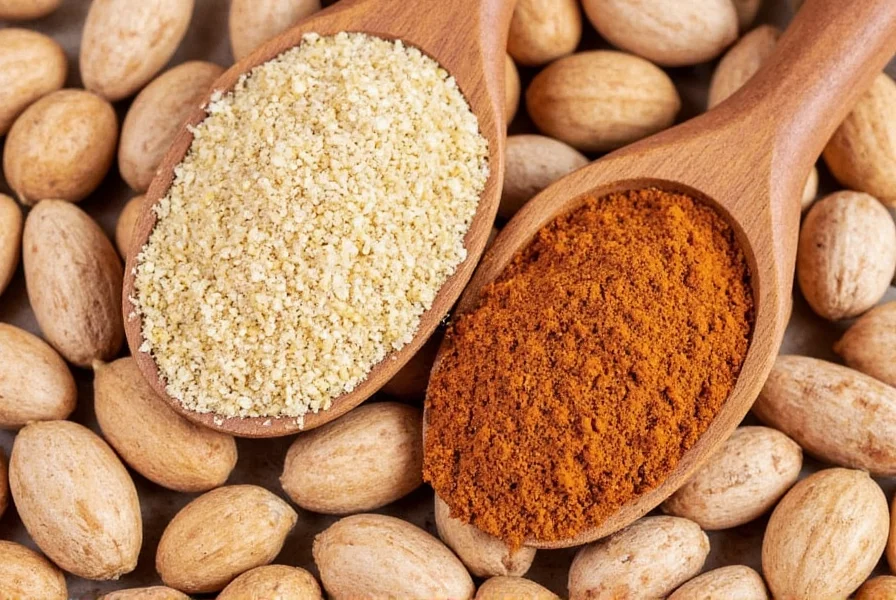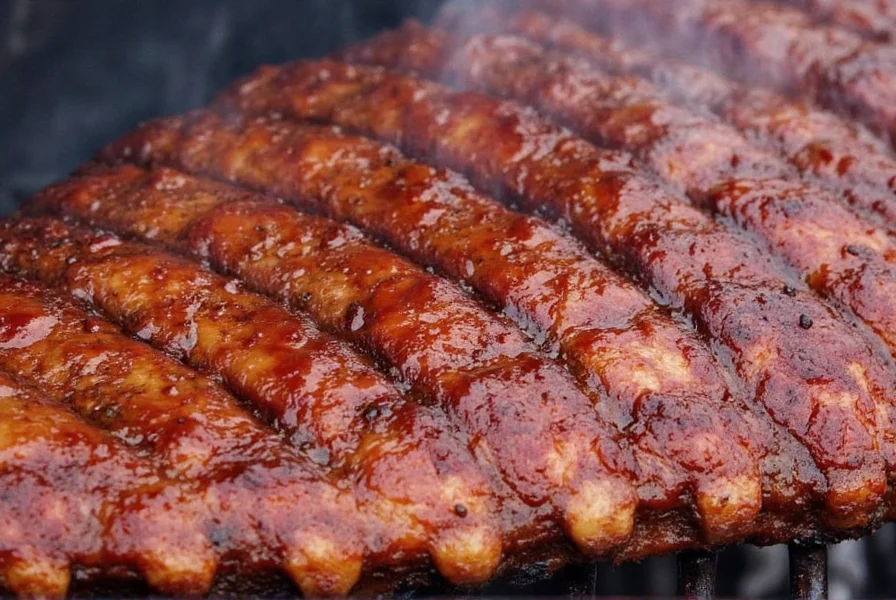Nutmeg and mace are two distinct spices derived from the same fruit, Myristica fragrans. While they share a similar flavor profile, nutmeg has a stronger, nuttier taste, while mace is more delicate and floral. This guide breaks down their key differences in flavor, appearance, uses, and storage to help you choose the right spice for your recipes.
| Feature | Nutmeg | Mace |
|---|---|---|
| Source | Seed of Myristica fragrans | Aril surrounding the seed |
| Form | Solid seed (grated) or ground | Dried blades or ground |
| Flavor Intensity | Stronger, robust | Softer, nuanced |
| Color | Warm brown | Orange-red to golden |
| Best For | Cheesecakes, béchamel, mulled wine | Puddings, custards, white sauces |
What Is Nutmeg?
Nutmeg comes from the seed of the Myristica fragrans tree, native to the Banda Islands in Indonesia. Once harvested, the seed is dried until it hardens into the familiar brown, oval-shaped spice we know and love. It has a rich, slightly sweet, and nutty aroma with hints of clove and pepper.
The Flavor Profile
- Bold, earthy, and warm
- Subtle sweetness with woody notes
- Ideal for both sweet and savory dishes
What Is Mace?
Mace is the delicate red-orange aril that covers the nutmeg seed before it dries. This lacy membrane is carefully removed, flattened, and dried into thin, translucent blades or ground into powder. While mace shares many flavor notes with nutmeg, it's generally more delicate and slightly sweeter.

Flavor Notes
- Gentle warmth with floral undertones
- Fruity and slightly citrusy compared to nutmeg
- Preferred in lighter sauces and baked goods
How to Use Nutmeg and Mace in Cooking
Both spices bring depth and complexity to your cooking but knowing when to use each can elevate your dishes. Here's how:
Nutmeg Shines In:
- Baked Goods: Pies, cakes, gingerbread, and holiday cookies
- Drinks: Eggnog, chai tea, and spiced lattes
- Savory Dishes: Macaroni and cheese, meatloaf, béchamel sauce
Mace Excels At:
- Light Sauces: Cream-based sauces, especially in Indian or European cuisine
- Sweet Treats: Custards, puddings, rice pudding
- Marinades: For fish or poultry where subtlety matters
Buying Guide: Choosing Quality Nutmeg & Mace
When shopping for nutmeg spice mace, focus on freshness, source, and form. Here's how to choose wisely:
Whole vs. Ground: Which to Buy?
| Type | Pros | Cons |
|---|---|---|
| Whole Nutmeg | Fresher flavor, lasts longer | Needs grater, not as convenient |
| Ground Nutmeg | Easier to use, great for baking | Loses potency faster |
| Mace Blades | Superior flavor, versatile | Hard to find in some regions |
| Ground Mace | Easy to sprinkle, blends well | Mild flavor, may be overpowered |
Top Picks for Nutmeg & Mace Brands
- La Flor Nutmeg: Premium whole seeds from Grenada; perfect for grating at home
- Simply Organic Nutmeg: Certified organic, sustainably sourced ground nutmeg
- Frontier Co-op Mace Blades: Whole mace from high-quality sources, ideal for simmering into sauces
- McCormick Ground Mace: Widely available, consistent flavor for everyday cooking
Storage Tips for Maximum Freshness
To preserve the flavor and aroma of your nutmeg spice mace:
- Store whole nutmeg in an airtight container away from light and moisture
- Keep ground spices sealed tightly and use within 6–12 months
- Mace blades should be kept in a cool, dry place — avoid refrigeration
- Avoid exposing to heat, which accelerates oil evaporation and reduces potency

Common Mistakes (and How to Avoid Them)
Even seasoned cooks sometimes misuse nutmeg and mace. Here's how to stay on track:
- Overuse: A little goes a long way! Start with a pinch and adjust gradually.
- Using old spices: Stale spices lack punch — replace every year for optimal results.
- Confusing the two: Mace isn't just "weaker nutmeg" — they play different roles in recipes.
- Grinding too early: Grate only what you need right before using for best flavor.
Frequently Asked Questions
Can I substitute mace for nutmeg?
Yes, in many cases, but keep in mind mace is milder. You might need to increase the quantity slightly, or combine with a touch of cinnamon for extra warmth.
Is fresh-grated nutmeg better than pre-ground?
Absolutely. Whole nutmeg retains essential oils longer and delivers a richer flavor. Invest in a microplane or nutmeg grater for best results.
Are nutmeg and mace safe to consume daily?
In culinary amounts, yes. However, consuming large quantities (especially raw) can cause side effects due to myristicin content. Stick to 1/4 teaspoon or less per serving for safety.
Can I grow my own nutmeg plant?
You can — but it takes 7–9 years to bear fruit, and requires tropical conditions. Best suited for botanical gardens or greenhouses in cooler climates.
Why does my nutmeg taste bitter sometimes?
When nutmeg is overused or exposed to high heat for too long, it can develop a bitter taste. This is especially true with pre-ground nutmeg, which loses its delicate oils more quickly. To avoid bitterness, use nutmeg sparingly and add it toward the end of cooking.
What spices pair well with nutmeg and mace?
Nutmeg and mace pair beautifully with cinnamon, cloves, ginger, allspice, and cardamom. For savory dishes, they complement garlic, thyme, rosemary, and sage. In desserts, they work wonderfully with vanilla, chocolate, and citrus zest.
Is there a difference between Indonesian and Grenadian nutmeg?
Yes, there are subtle differences. Indonesian nutmeg tends to be slightly more robust and aromatic, while Grenadian nutmeg (often called "East Indian" nutmeg) is prized for its sweeter, more delicate flavor. Grenada actually features nutmeg on its national flag, earning it the nickname "The Spice Island."
How can I tell if my nutmeg is fresh?
Fresh whole nutmeg should have a strong, sweet aroma when scratched with a knife. The seed should be hard and heavy for its size. For ground nutmeg, check for a vibrant aroma - if it smells faint or musty, it's likely stale. Fresh nutmeg also has a rich brown color, while stale nutmeg appears duller.
Can nutmeg help with sleep?
Traditionally, a small pinch of nutmeg added to warm milk has been used as a natural sleep aid. Nutmeg contains compounds that may have mild sedative effects, but scientific evidence is limited. It's important to use only a tiny amount (1/8 teaspoon or less) as larger quantities can cause adverse effects.
What are the health benefits of nutmeg and mace?
Both spices contain antioxidants and have anti-inflammatory properties. Nutmeg may aid digestion and support brain health in small culinary amounts. Mace has similar benefits with potentially stronger antimicrobial properties. However, these should be consumed in moderation as part of a balanced diet, not as medical treatments.
Conclusion
Nutmeg and mace are like cousins at a family dinner — related, but each bringing something unique to the table. Whether you're dusting nutmeg over your morning latte or infusing mace into a silky custard, understanding their nuances helps you cook with confidence and flair. So go ahead, open that spice drawer, and let these warm, aromatic wonders transform your meals one pinch at a time.
Remember, a little nutmeg spice mace goes a long way — and the magic they bring to your food is truly timeless.










 浙公网安备
33010002000092号
浙公网安备
33010002000092号 浙B2-20120091-4
浙B2-20120091-4